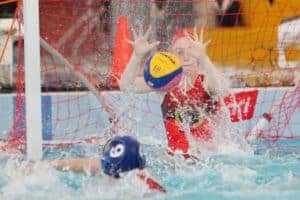Basic Rules of Water Polo

Basic Rules of Water Polo
The following information provides a snapshot of the rules of the game and should not be seen as a substitute for the Official Rule Book. The FINA rules can be found here.
Length of Game
The duration of a game of water polo is four eight minute periods. Time commences at the start of each period and the clock is stopped throughout the game during stoppages with time resuming once the ball is put back in the field of play either by a player taking the appropriate throw or when the ball is touched by a player following a neutral throw.
There are two minute intervals between time periods with a five minute break at half time. Should the scores be even at full time, two three minute periods of extra time will be played in the event that a definite result is required. Should scores remain level at the end of extra time a penalty shoot out will occur.
Starting the Game
At the start of each period players take up positions on their respective goal lines about one metre apart and no closer than one metre from the goal posts. A referee will blow the whistle to start the game and then release a ball into play in the middle of the pool.
Time Outs
Each team may request two timeouts in any game. An additional time out, in addition to any time outs not used during ordinary play may be requested during extra time. A timeout is one minute in duration and may be requested at any time and the game is immediately stopped.
Scoring a Goal
A goal is scored when the entire ball passes full over the goal line, between the goal posts and underneath the cross bar. A goal may be scored from anywhere within the field of play, however, the goal keeper may not touch the ball beyond the half way mark. A goal may be scored by any part of the body except a clenched fist.
Team Changes and Substitutions
Each team consists of seven players (including a goal keeper), and not more than six reserves who may be used as substitutes. All players not in the game at the time sit on the team bench situated on the side of the pool. At any time in the game a player may be substituted by leaving the field of play with the exception of when a referee awards a penalty.
Fouls & Free Throws
There are several different types of fouls which the referee will not permit including; ordinary fouls, exclusion fouls, penalty fouls, and personal fouls. In the event of a foul the referee may award a free throw or penalty throw.

Playing Positions
Goal Keeper (GK)
The person playing this position has a vital defensive role while also supporting their teammates when on the offensive attack. For example, in a counter attack, the goal keeper would be responsible for distributing the ball down the pool.
Once a pass is made from the keeper to another player on the team, the keeper will often egg beater to about the 5m mark and be ready for a potential return pass. Goal keepers must always be aware of their position relative to the ball, so being aware of where the ball is even when it is on the other side of the pool is important as the keeper needs to be in the optimal position.
It’s also important for goal keepers to stay engaged in the game as they often have the best vision of the entire pool and play an important role in communicating what they see to their teammates. For example, if there is a player open down the pool that the ball handler does not see, then it is the goalkeeper’s responsibility to yell it out and keep teammates informed and aware.
Centre Forward (CF)
The centre forward position is on the 2m line. The outer positions (such as points, wings and drivers) are responsible for getting the ball into the CF. Balls are usually passed into the CF using a wet pass. There, the CF will either take the ball and shoot or draw a foul. The CF position will usually be played by one person more, as opposed to switching positions, due to the strength and skills required.
Centre Back (CB)
A centre back is a player who defends the CF. The CB’s main aim is to prevent the CF from scoring, often deliberately committing ordinary fouls. The CB may be supported by the other team members by calling a zone or may defend one-on-one in a press situation.
Drivers
These positions do the most swimming and often change positions several times during a single play. Drivers are constantly creating movement by driving down to the goal post and rotating around, or creating screens in order to free teammates of their defenders. Their main job is to get the ball into the CF. Their proximity to the goal and their position relative to the CF make them invaluable components for scoring goals.
Utility
Utility players are those players who are comfortable playing all positions. The utility players are the strongest players in the team, who swap places with other players whenever there is an opportunity to score. Utility players are most effective when they drive in and play CF and quickly score against a defender, who is inexperienced in that position.
